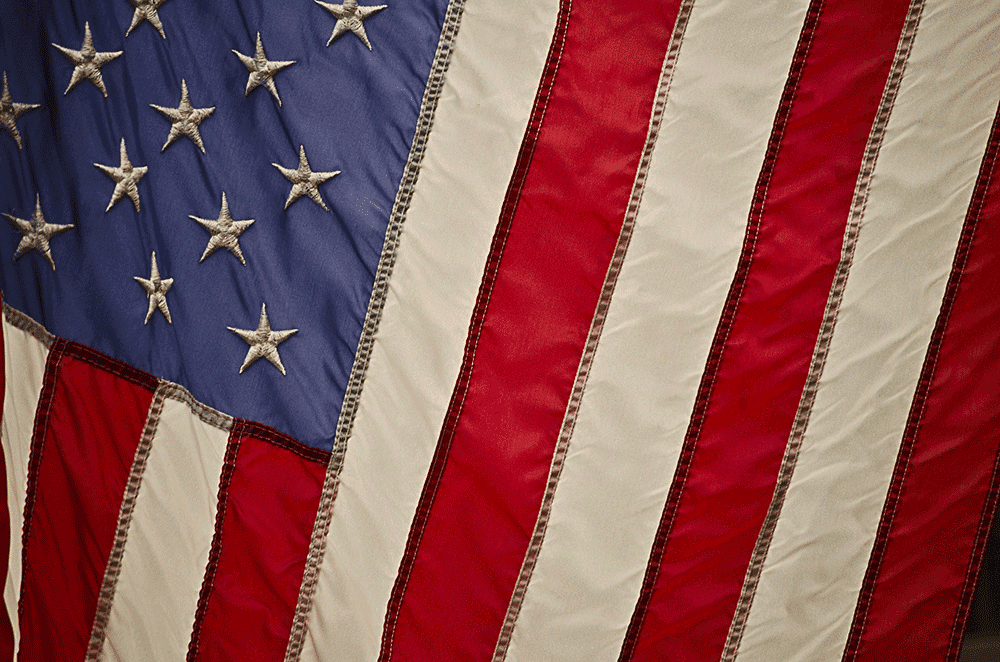
 Storage Tips
Storage TipsAmerican Flag Etiquette: Display, Cleaning, & Storage
Patriotic Americans like to fly the American flag on national holidays and other occasions. Some fly the flag every day. Others bring their flag out of storage each year to fly it on the Fourth of July to celebrate American Independence Day. The guidelines of proper handling of the American flag come from the Flag Code that was created as a national standard during the National Flag Conference in 1923.
What the American Flag Colors Stand For
There is an interesting history regarding the colors used for the American flag. They are the same color scheme as the Union Jack flag for Great Britain of red, white, and blue. There is no historical evidence of any symbolic meaning of the flag's colors except that they were also used by Charles Thomson as the secretary of the Continental Congress to create the Great Seal of the United States. Thomson noted in his congressional report made on June 20, 1782, that red is for valor and hardiness, white symbolizes innocence and purity, and blue is for justice, perseverance, and vigilance.
The United States Flag Code Guidelines
The Flag Code started as law of the land in the 1920s but has since been modified to be only guidelines by some rulings of the Supreme Court, which upheld degradation of the U. S. flag as an expression of free speech.
For those who prefer to take good care of their American flag and follow the Flag Code, here are some tips about cleaning the flag, displaying the flag, and putting it away in storage.
How to Clean a Flag
Depending on what fabric your flag is made out will determine how to properly care for it while cleaning. Cotton or wool flags are more fragile than their nylon, polyester, or other fabric blends.
- For cotton and wool flags, you can hand-wash them with mild soap and water. It is recommended to take it to a professional dry cleaner if you want to protect your flag damage or color bleeding. You may use a cool iron to remove wrinkles from your flag or let it air dry.
- Nylon, polyester, or other fabric blends can be machine washed on the delicate cycle with cold water and mild soap. Some flags may have washing instructions on them. Consult those instruction first before washing and drying. Do not place your flag in the dryer after it has been washed as the fabric can be damaged. Instead you may use an iron to press out any wrinkles that have formed. Be careful with nylon fabrics as those tend to melt when exposed to hot irons.
Avoid Running Colors
Regardless of how you wash your flag, you want to make sure flag's fringe is dry to prevent colors from running and bleeding. Pat dry before letting it dry on a flat surface.
Vacuuming Older Flags
Older flags may be damaged by washing or cleaning them. To remove dust from an older flag, vacuum the flag with the brush attachment that is covered by clean cheesecloth that prevents the flag from being sucked into the vacuum. Do not rub the vacuum brush across the flag's surface. Instead, pat the brush attachment on the surface in a blotting motion, to remove dust.
How to Store a Flag
The traditional folding of a flag into a neatly packed triangle is only useful for flags that are displayed daily. This is not a good method to use if storing a flag for an extended period. To put a flag away in storage for a while, it is better to store it flat in a box. You can also store a flag rolled up using archive tissue paper for a protective layer between the flag fabric and then put it in a tube.
A box or tube made out of acid-free materials is best. Use one made from polypropylene plastic because storing a flag in a cardboard or wooden box may cause discoloration. Do not use mothballs because the chemicals in them, when they are in close contact with the flag fabric, may cause damage.
It is not a good idea to store your flag in a basement, attic, or a garage. Because of severe fluctuations in temperature and humidity found in these areas, it is likely that the flag will be damaged. Excessive humidity can easily ruin a flag by allowing mold and mildew to grow on the fabric. Instead, store the flag in a climate-controlled storage unit for the best results. The flag will store better in a place that has steady, safe temperature range and low relative humidity.
Displaying an American Flag
The Flag Code covers three methods of displaying the American flag properly, which are the following.
- Hanging from a mounted staff
- Hung vertically or on a wall
- Flying from a flagpole
A staff can be mounted on the outside of a building, come out a window, or connect to a balcony. When hanging a flag on a staff, make sure the stars are at the highest portion of the staff, unless the flag is flying in a half-staff position.
When a flag is hung in a vertical orientation, such as over a street, make sure the stars are either to the northern or eastern directions. When a flag is hung over a sidewalk in front of a building the stars should be on the side away from the building.
A flag may be hung either vertically or horizontally on a wall. In this case, make sure the stars are at the top to the right side of the flag from the flag's perspective, which the observer sees as the top, left side.
To hang a flag from a flagpole, run it up to the top of the mast. Make sure to fly the flag with no other pennant or flag above it. There is only one exception to this rule, which allows a naval sea chaplain to fly a Christian or other church (Jewish or Muslim) pennant above the American flag when presiding over memorial services.
Disposing of an American Flag
In the unfortunate event that you are not able to clean and store your flag, you will have to properly dispose of it. According to the United States Flag Code, "The flag, when it is in such condition that it is no longer a fitting emblem for display, should be destroyed in a dignified way, preferably by burning."
- Burning: The first step is to show respect by folding your flag properly. Once folded, build a fire that's large enough to ensure your flag is will be burned completely. After the fire is ready, carefully place your flag on top of the flame. As your flag burns, show your respect by having a moment of silence. Some people choose to salute, others sing the national anthem, and say the Pledge of Allegiance. Remain respectful and never make casual chit-chat, make jokes, or divert your attention to your phone. Once your flag is burned completely, make sure you take the time to properly put out the fire.
- Burial: While burning is the preferred way to dispose of an American flag, some people choose to bury it. First, fold your flag properly. Next, find a box that shows proper respect for the flag. Many choose a wooden box to bury their flag. Avoid reusing cardboard boxes such as shoe boxes. The number one rule of disposing an American flag is showing proper respect. After the flag is placed in the ground, have a moment of silence, give a short speech. You may also say the Pledge of Allegiance.
- Donation: If you do not have the means or space to properly dispose of your flag consider donating it to either The American Legion, Veterans of Foreign Wars, The Boy Scouts of America, the Girl Scouts of America, or the US Military. These organizations will be able to dispose of your flag with a proper ceremony for no charge.
A Grand Old Flag
By following these tips you will be able to keep your flag clean, stored it for an extended period, and then display it properly when the occasion arises.
We're Your Storage Solution!
Storage Rentals of America is your convenient self-storage solution. So come into our office or give our storage experts a call at 1-800-457-5678. Our call center is available 7 days a week and can help determine which storage unit size best fits your storage needs.



